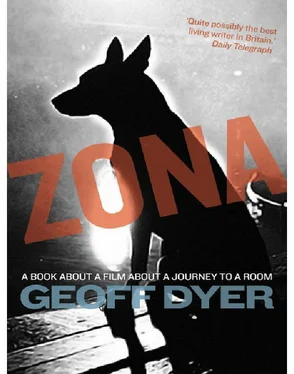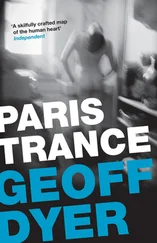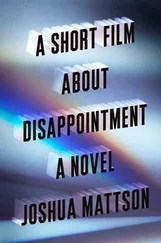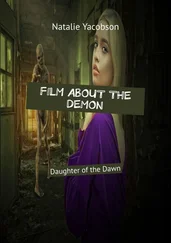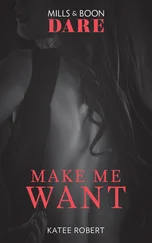16Or maybe not. In the years when I used to go to Burning Man in the Black Rock Desert, we were greeted at the festival entrance with the words ‘Welcome home!’ and tears always welled up in my eyes because it was true, because I believed absolutely in the Temporary Autonomous Zone of Black Rock City.
17I am reminded of the time, in Big Sur, when a friend and I were perched on the edge of cliffs, overlooking the fog-shrouded Pacific. Perhaps the fog sealed in the sound of the ocean below. There was no wind. It was absolutely quiet. We were the only people there until a family turned up and the father, eager to articulate the charm of the place, boomed out, ‘Must be real peaceful here!’
18This is one of several occasions when what we are hearing and seeing on-screen echoes something from the making of the film. Preparing a later shot, when Writer rejects Stalker’s warning and starts walking straight towards the Room, Tarkovsky noticed that a few dandelions had blossomed — if that’s what dandelions do — thereby spoiling the look of the scene. Production designer Rashit Safiullin and his team were sent to pluck them out. A simple enough task, except the Zone also had to look like no one had ever set foot there, so they needed to make sure that in the process of plucking the dandelions they left no sign of their own work, no flattened grass or footprints. The dandelions had hardly been obtrusive but even when they were removed so that shooting could begin Tarkovsky was not happy: ‘Rashit, the flowers are not here but their presence can be felt.’
19Lars von Trier takes this aspect of the Zone and raises it to a Hammer Horror — ish degree in Antichrist (2009). The most offensive thing about Antichrist —worse than the clitoridectomy, the drill through Willem Dafoe’s leg and the blood ejaculating from his dick — was that it was dedicated to Tarkovsky. I couldn’t believe it. In the classic Satanic Verses style of the offended, I did not need my outrage to be corroborated by actually seeing the film. Then I did see it. And, in its weird, perverse way, amongst all the silliness and nonsense — of which there is a vast amount— the film is, very obviously, a warped love letter to Tarkovsky, shot through with allusions, nods and references. At times it looks exactly like a Tarkovsky film. Right at the start, when Dafoe and Charlotte Gainsbourg— gorgeous to look at but, in this instance, hopeless as an actress — are having sex, there’s a bottle falling over and leaking water onto the floor, as in Mirror and, less exactly, Stalker. But it’s when they set out for the forest, to Eden, that they head, unmistakably, into the dense remembered green of Mirror. (Actually, some of the CGI scenes in the forest, the fairy tale bits, are maybe more reminiscent of the enhanced forest of Aleksandr Sokurov’s Mother and Son than Tarkovsky’s almost-ordinariness.) The cabin in the woods, the wind appearing from nowhere whipping through the foliage, the orange bonfire, the sense of a landscape being haunted by memory — all of this is wonderful. Some sequences seem even more specifically allusive: the moment when Dafoe turns to the camera as if alerted either by some unspecified external stimulus or in the midst of some inward realization (pure Tarkovsky, that collapsing of the internal and external), or the sequence when we follow him, in his overcoat, from behind, through the ferns and leaves. These are authentic tributes to Tarkovsky, admiring glances from one director to another. Not that Antichrist is any kind of Tarkovsky pastiche; von Trier sees what is special about Tarkovsky but does something uniquely his own. What he does is absolutely repellent and silly — a waste. Antichrist is daft in the way all horror films are daft, especially when seen beside the routine horrors of modern life.
In von Trier’s favour, if you wanted to mount a case for this as a serious — as opposed to a beautifully shot, thoroughly stupid — film, you could say that this is a trip into a mirror image of Tarkovsky’s Zone. Whereas in Stalker the Zone is a place where your deepest wish could come true, here it’s a place where your most horrible nightmares will be revealed, your — or Charlotte’s — deepest fears, the terrors at the apex of the pyramid of terror described by Dafoe. But I don’t want to give Antichrist too much credit: it’s nonsense, a highly crafted diminution of the possibilities of cinema.
20Rather different but even more extraordinary documentary corroboration of the existence of some kind of Zone is provided by Magnum photographer Jonas Bendiksen in his book Satellites, particularly the images from the socalled spacecraft crash zone in Kazakhstan and just across the border in the Altai Republic of Russia. The debris that regularly came crashing from space gave rise to a thriving unofficial business here — in spite of the risks — in scrap and salvage. Bendiksen’s most famous — and beautiful— photograph shows two villagers atop the dented remains of part of a spacecraft or satellite in the midst of an idyllic green landscape and blue sky, all snow-blurred by the wings of thousands of white butterflies.
21Again, myth and reality have become intertwined in the years since Chernobyl. Freed from human interference animals thrived in the Zone of Exclusion. Species not seen for centuries returned or were reintroduced: lynx, wild boar, wolf, Eurasian brown bear, European bison, eagle owl, moose, beaver, Przewalski’s horse (whatever that is). The population of already established species increased. A new generation of trees took root, settled in. The forest surrounded and then advanced unimpeded into the excity. With animal and plant life flourishing in this way, the Ukrainian government put a positive — and entirely logical — spin on the idea of exclusion and, in 2007, designated the area a wildlife sanctuary. (Scientists who carried out a census and published their findings in Ecological Indicators dispute these claims of increase and abundance. They found a diminution in the diversity and numbers of mammals but welcomed the idea of a wildlife haven as a kind of natural laboratory to further study the effects of radiation.)
22If so, then there is an evocative and extraordinarily apposite account of how this might feel in the testament of a schizophrenic patient, as reported by Merleau-Ponty in Phenomenology of Perception: ‘Once I was a man, with a soul and a living body and now I am no more than a being…I hear and see, but no longer know anything… I now live in eternity…The branches sway on the trees, other people come and go in the room, but for me time no longer passes.’
23There’s a lot of back-of-the-head stuff in Stalker; maybe Darren Aronofksy got the idea for the opening sequence of The Wrestler (2008) from Tarkovsky, building up the suspense because we all wanted to know just how beat up Mickey Rourke’s face looked after all those years getting beat up in the cinematic wilderness. It might also be relevant — because of the whole space-time thing — that Einstein said that an infinitely powerful telescope would reveal the back of the viewer’s head.
24In 1978, while Tarkovsky was struggling to complete Stalker, Kollektivnye Deystviya (Collective Actions) arranged for a small number of visitors to travel to a field outside of Moscow. The otherwise ordinary field had been doubly transformed: subtly, by the expectations, uncertainties, arrangements, and reputation of what the Collective termed ‘Trips Out of Town’; explicitly by the banner slung between trees that articulated the visitors’ experience of mysteriously heightened ordinariness: ‘I wonder why I lied to myself that I had never been here and was totally ignorant of this place — in fact, it’s just like anywhere else here, only the feeling is stronger and incomprehension deeper.’ The banner was unfurled again — this time with what seemed explicit references to the Gulag — as part of ‘Empty Zones’, a retrospective of the Collective’s work at the Russian Pavilion of the 2011 Venice Biennale.
Читать дальше
